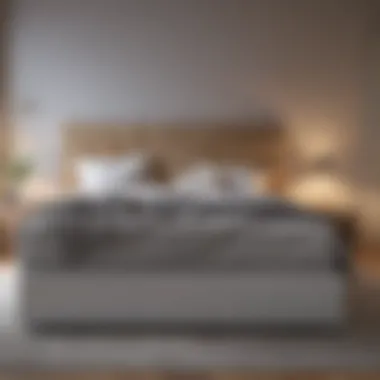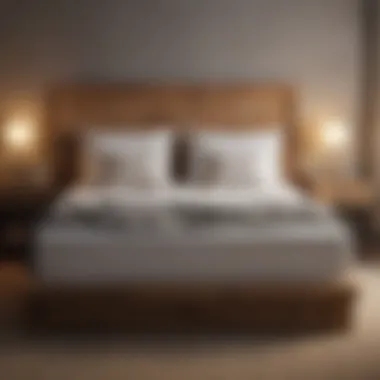Comprehensive Guide to Full Bed Dimensions


Intro
Understanding the standard full bed dimensions is key to making informed decisions about your bedroom setup. A full bed, also known as a double bed, has specific measurements that differ from other sizes like twin or queen. Knowing these dimensions can significantly impact the overall aesthetics and functionality of your space. This section will provide an in-depth look into the measurements, design considerations, and how these influence bedding choices.
In the following sections, we will explore the nuances of full bed dimensions and their relevance in today’s interior design. We will also discuss the variations available in the market, which can cater to different styles and preferences. Understanding these elements allows homeowners and design enthusiasts to create balanced and inviting environments.
Design Inspiration
Incorporating a full bed into your bedroom design requires attention to style and color. With thoughtful design choices, a full bed can serve as a stunning focal point in the room.
Trending Styles
Modern bedroom trends often blend comfort with style. Here are some popular trends regarding full bed designs:
- Minimalism: A clean, uncluttered look using neutral colors.
- Bohemian: Rich textures and vibrant colors that invite warmth and creativity.
- Industrial: A combination of metal and wood elements for a more rugged aesthetic.
Color Palettes
Choosing the right color palette can enhance the look of your full bed. Common palettes include:
- Cool tones: Blues and greens evoke calmness.
- Warm tones: Yellows and oranges can create a cozy atmosphere.
- Monochrome: Black and white schemes offer a timeless feel.
Selecting the right colors not only impacts design but also influences mood, creating a space where you feel at ease.
Practical Tips
Maintenance & Care
Maintaining your full bed is crucial for longevity and comfort. Here are some tips:
- Rotate your mattress every three to six months to ensure even wear.
- Use a mattress protector to avoid stains and spills.
- Regularly check and tighten bed frames to ensure stability.
Budgeting & Planning
Investing in a full bed can vary based on quality and style. Here are some budgeting tips:
- Determine your budget before shopping.
- Research brands and read reviews to find quality options.
- Consider buying second-hand for more affordable choices.
Planning ahead can help you make aware choices and avoid overspending.
"Understanding bed dimensions is essential for creating a balanced space. A well-chosen full bed can harmonize a room and improve the quality of life."
With this information, you are better equipped to navigate the complexities of selecting a full bed that suits your needs. Explore options that reflect your style and marry functionality with aesthetics.
Preamble to Full Bed Dimensions
When selecting a full bed, several specific elements come into play. First, clarity on what constitutes a full bed simplifies the buying process. Additionally, familiarity with common measurements allows for better furniture arrangement within a room.
In the subsequent sections, we will explore the straightforward definition of a full bed. After that, we will delve into common measurements that define full beds, equipping the reader with practical insights for their bedroom configurations.
"The right bed dimension can transform a space, maximizing comfort and style."


Definition of Full Bed
A full bed, often referred to as a double bed, measures approximately 54 inches in width and 75 inches in length. This makes it wider than a twin bed, providing more sleeping space for individuals or couples. The full bed is a suitable choice for those who may require more room than what a twin offers but do not have the space for a larger bed. These beds strike a balance between size and practicality, serving well in guest rooms or smaller master bedrooms.
Common Measurements of Full Beds
Common measurements of full beds are vital to understand when planning bedroom arrangements.
- Width: 54 inches
- Length: 75 inches
These dimensions provide enough space for one to sleep comfortably while not overwhelming a room. However, it is important to recognize that taller individuals may find the length limiting, especially when compared to queen or king-sized beds.
Additionally, a full bed can also come in various thicknesses that depend on the mattress style. Understanding these measurements will help in selecting appropriate bedding and ensuring that furniture complements the bed's dimensions effectively. Knowing full bed measurements also assists in the choice of bed frames and other accessories, enabling homeowners to design a cohesive aesthetic.
Standard Dimensions of Full Beds
Understanding the standard dimensions of full beds is crucial for anyone looking to optimize their bedroom space and ensure comfort. The full bed, often referred to as a double bed, is a popular choice for couples and individuals alike. It provides a balance between size and functionality, making it suitable for various types of living spaces. Knowing the dimensions helps you avoid common pitfalls such as poor mattress fit or bedding that does not cover the bed appropriately.
In this section, we will discuss the two primary aspects of full bed dimensions: width and length specifications, along with average height considerations. Assessing these factors can help you make informed decisions when purchasing a mattress or choosing bedding accessories appropriate for your full bed.
Width and Length Specifications
The standard width of a full bed is typically 54 inches, with a length of 75 inches. This size allows for enough space for a single sleeper, yet can also accommodate two people with some room to spare. However, the dimensions can vary slightly depending on the mattress manufacturer or specific model. Therefore, it is advisable to verify measurements before making a purchase.
The dimensions play a significant role not only in the comfort level but also in the overall room layout. For example, a full bed is often considered a good option for smaller rooms where a larger bed would not fit without compromising other elements of the space. Here are some considerations:
- Comfort: The width allows for two individuals to sleep side by side comfortably, yet not too much space that it creates unnecessary distance.
- Space Efficiency: Fits well in small to medium-sized bedrooms, making it a versatile choice.
- Usage: Ideal for guest rooms where flexibility in accommodating one or two guests is a priority.
"A full bed serves as the perfect compromise between space and comfort for many living situations."
Average Height Considerations
The average height of a full bed can vary based on the bed frame, mattress type, and whether a box spring is used. Typically, full beds range from 18 to 25 inches in height from the floor to the top of the mattress. This height can influence how easily one can get in and out of bed.
When selecting a bed height, consider the following:
- Accessibility: A lower bed may be easier for some individuals, particularly those with mobility issues.
- Aesthetic Appeal: The height can impact the overall look of the room; taller beds may require different types of bedding or decorative elements.
- Storage Options: Higher beds can create space underneath for storage, which may be beneficial in smaller rooms.
Understanding the height and its implications allows for tailoring the bedroom environment to personal preferences and practical needs. Choosing the right height is as important as selecting the right width and length, ensuring optimal comfort and design cohesion for the overall space.
Full Bed Variations and Alternatives
Full bed variations and alternatives play a crucial role in understanding how this style of bed fits within diverse space requirements and personal preferences. By examining the differences between full beds and other types such as twin and queen beds, homeowners can make informed decisions based on their unique needs. The right choice affects not just comfort, but also the overall design and functionality of a bedroom.
Comparing Full Beds to Twin Beds
When comparing full beds to twin beds, the key distinction lies in size and sleeping capacity. A standard twin bed measures 38 inches wide by 75 inches long, while a full bed is typically 54 inches wide and 75 inches long. This difference offers a significant increase in width.
For individuals sleeping alone, a twin bed may suffice, but for couples or those seeking more personal space, a full bed is a more logical choice. The extra width of a full bed allows for greater comfort during sleep, avoiding the feeling of confinement often associated with the narrower twin options. Moreover, the increased sleeping area can be advantageous, especially for those who tend to move around while sleeping.
Distinguishing Full Beds from Queen Beds
Full beds and queen beds both provide ample sleeping space, yet they cater to different needs. A queen bed is wider and longer than a full, measuring 60 inches in width and 80 inches in length. This extra size enhances comfort for couples, particularly if they have different sleeping positions or preferences.


For smaller rooms, full beds offer a practical choice as they occupy less space than queen beds, making them suitable for youth bedrooms or guest rooms. However, for those prioritizing comfort, especially when sharing a bed, the queen option may be ideal. It provides more breathing room, reducing the likelihood of disturbances during the night.
Customization Options for Full Beds
Customization is a vital aspect of full beds. Unlike traditional models, many manufacturers offer customizable features. Adjustable bases, like those from Tempur-Pedic, can add a layer of convenience and comfort for users. This option allows for personalized sleeping positions, ideal for individuals who may need to elevate their head or feet for health reasons.
Moreover, aesthetics can also be customized. Bed frames for full beds come in various styles, colors, and materials, allowing homeowners to select designs that match their interior decor. From minimalist frames to upholstered styles, the possibilities are extensive. Accessories such as specialized mattresses, pillows, and bedding can also be tailored to meet personal preferences, ensuring that each full bed setup reflects the individual taste of its owner.
Choosing the Right Mattress for Full Beds
Selecting the appropriate mattress for a full bed is a vital step that can significantly affect both comfort and rest quality. The full bed size, with its dimensions of 54 inches wide by 75 inches long, necessitates a well-matched mattress to maximize sleep experience. A well-chosen mattress can relieve pressure points, align the spine, and improve sleep overall.
When considering a mattress, homeowners must evaluate various elements such as firmness, material, and support levels. The right choice leads not only to better sleep but also to increased longevity of the mattress itself as it supports the body effectively. Moreover, a suitable mattress enhances the aesthetic appeal of the room, complementing the overall design and ensuring that functionality meets style.
Types of Mattresses Available
There is a diverse array of mattress types suitable for full beds. Each type offers unique characteristics and benefits. Some common options include:
- Innerspring Mattresses: These traditional mattresses feature a coil support system. They are bouncier and generally provide good airflow, making them cooler to sleep on.
- Memory Foam Mattresses: Known for their contouring properties, these mattresses conform to the body, providing pressure relief and support. They are ideal for those seeking a more cushioned feel.
- Latex Mattresses: Made from natural or synthetic latex, these mattresses offer durability and good bounce. They are hypoallergenic and often cooler than memory foam options.
- Hybrid Mattresses: Combining innerspring and foam, these mattresses provide a balanced mix of support and comfort. They target diverse sleeping positions.
- Adjustable Air Mattresses: These customizable options allow users to alter firmness levels, which can be beneficial for couples with different preferences.
Finding the right mattress type helps ensure personal preferences align with sleep needs, ultimately leading to improved health and well-being.
Mattress Thickness and Support Considerations
Mattress thickness is another critical factor to weigh when choosing for a full bed. Generally, mattresses range from 6 to 14 inches in thickness, with most falling in the range of 10 to 12 inches.
The following points illustrate important considerations surrounding thickness:
- Comfort Layer: Thicker mattresses often have a more substantial comfort layer, offering better pressure relief. This can be essential for side sleepers who need that extra cushioning for hips and shoulders.
- Support Core: The support core should be strong enough to maintain spine alignment. Adequate support is crucial to avoid discomfort and potential back issues over time.
- Weight and Material: Heavier individuals may require thicker mattresses to prevent sagging and to achieve proper support. Also, materials like memory foam may compress more under weight than firmer options, thus worth considering when determining thickness.
Ultimately, choosing the ideal thickness depends on individual sleep preferences and body types.
"The right mattress can dramatically influence your sleep quality, health, and comfort levels."
In summary, selecting the right mattress for a full bed involves assessing various factors, including type, thickness, firmness, and support characteristics. A conscious approach will lead to decisions that benefit sleep and overall well-being.
Bedding Accessories for Full Beds
Bedding accessories for full beds play a crucial role in not just aesthetics, but also in comfort and functionality. Selecting the right bedding and accessories ensures that a full bed not only looks appealing but also enhances the overall sleeping experience. It involves consideration of materials, styles, and practical aspects that impact the bedroom environment. For homeowners and design enthusiasts, understanding these elements is essential for creating a cohesive and functional space in which to unwind.
Selecting Appropriate Bedding Sizes
When curating bedding for full beds, size accuracy is paramount. The standard dimensions for a full bed are typically 54 inches wide by 75 inches long. Therefore, it's vital to choose bedding that is proportionate to these measurements. Common bedding items include fitted sheets, flat sheets, and comforters. Each should correspond directly to the full bed size for a snug fit.
- Fitted sheets must be designed specifically for full bed dimensions to avoid bunching or slipping off during the night. Choosing deep pocket options can also be beneficial if the mattress has added height due to mattress toppers or specific designs.
- Flat sheets can be standard full sizes, allowing for enough overhang while maintaining a clean look.
- Comforters and duvet covers should not only fit the bed but also allow for adequate draping over the sides, enhancing warmth and style.
Beyond size, material is another significant factor. Breathable fabrics like cotton or bamboo are often preferred for their softness and moisture-wicking properties. This becomes essential for comfort, especially in varying seasonal weather.
Exploration of Bed Frames
The bed frame is another integral component when discussing bedding accessories. The right frame will both support the mattress properly and complement the overall decor of the bedroom. Full bed frames come in various styles ranging from modern to vintage, ensuring that there is an option for every design aesthetic.
When selecting a bed frame, consider the following:


- Material: Wooden frames offer durability and timelessness, while metal frames can provide a sleek and contemporary look.
- Height: Frames can come in various heights, affecting how high the mattress sits from the ground. This will influence the ease of getting in and out of bed.
- Storage: Some frames offer built-in drawers or space, providing practical storage solutions, particularly beneficial in smaller bedrooms.
- Style: Headboards can add character and function, providing back support for sitting up in bed, thus enhancing the room's overall design.
Practical Applications in Bedroom Design
Understanding full bed dimensions is crucial when designing a bedroom that is both functional and aesthetically pleasing. Full beds, also known as double beds, provide a balance between comfort and space efficiency. They cater to various needs, such as accommodating couples or individuals who prefer more sleeping space than a twin offers without occupying an excessive area. Knowing the dimensions allows homeowners and designers to optimize the use of available space, ultimately leading to strategic furniture placements and improved room flow.
Space Optimization Strategies
When it comes to optimizing space with a full bed, several strategies can be employed:
- Placement: Positioning the bed against the wall can create more open space in a room. This leaves enough floor area for movement and additional furniture such as nightstands or a dresser.
- Multi-functional Furniture: Incorporating items that serve multiple purposes, such as beds with built-in storage or ottomans that can act as seating and storage, maximizes efficiency in smaller rooms. This makes the bedroom not only more organized but also visually appealing.
- Vertical Space Utilization: Installing shelves or cabinets above the bed can free up floor space. Going vertical can draw the eye upwards, giving the illusion of a larger room while storing necessary items within reach.
Styling Full Beds in Various Interiors
Styling a full bed to suit different interior designs involves consideration of colors, textures, and complementary furniture. Here are some essential styling tips:
- Contemporary Style: Opt for a sleek bed frame, possibly with a minimalistic headboard. Neutral colors paired with bold accent pillows can bring a modern touch.
- Rustic Design: Wooden frames, soft linens, and earthy tones work well in rustic interiors. Layering different textures creates warmth and a welcoming atmosphere.
- Bohemian Vibe: A full bed can be adorned with eclectic patterns and vibrant colors. Mixing and matching bedding can infuse personality and charm into the room.
In essence, understanding how to integrate a full bed into different design styles not only emphasizes the bed as a focal point but also enhances the overall theme of the bedroom.
Key Takeaway: Well-considered practical applications of full bed dimensions can elevate the functionality and style of a bedroom, making it a serene space to retreat to.
Maintenance of Full Beds and Bedding
Maintenance plays a critical role in extending the lifespan of full beds and bedding. Proper upkeep not only keeps the bed looking and feeling fresh, but it also enhances hygiene and comfort. Regular attention to cleaning and care can prevent allergens and dust mites from negatively impacting one’s health. Moreover, knowing how to maintain full beds ensures that the investment in both the bed frame and mattress provides adequate returns over time.
Cleaning and Care Tips
Keeping a full bed clean involves several straightforward practices. The first step is to wash bedding regularly. Sheets should be changed weekly or bi-weekly depending on individual preferences and activity levels. This prevents the buildup of sweat, oils, and skin cells. Additionally, it is essential to wash pillowcases and pillow protectors with the same frequency.
Here are some key cleaning tips for maintaining a clean full bed:
- Vacuum regularly: Use a vacuum with a soft brush attachment to remove dust from the mattress and headboard. This practice is essential to keep allergens at bay.
- Spot clean stains immediately: Use a mild detergent mixed with water to clean any spills or stains on the mattress. Avoid soaking the mattress to prevent mold growth.
- Air out the mattress: Every few months, remove bedding and allow the mattress to breathe. This helps to expel moisture trapped inside.
- Use mattress protectors: Invest in a quality mattress protector to shield against spills and dirt. These protectors can be machine washed just like regular bedding.
In addition to these tips, always refer to the manufacturer's instructions for specific care recommendations for both the mattress and any bedding accessories.
Longevity Expectations
When it comes to longevity, a well-maintained full bed can last significantly longer than one subjected to neglect. Typically, a high-quality mattress can endure around 7 to 10 years. Factors that influence the lifespan of a mattress include the material, usage patterns, and how well it’s maintained.
- Foam mattresses usually last about 7-8 years.
- Innerspring mattresses tend to have a lifespan of around 8-10 years.
- Latex mattresses can last even longer, often exceeding 10 years with proper care.
The key to maximizing a mattress's lifespan lies in maintenance. Rotate the mattress every 6 months to even out wear. Check for signs of sagging or wear regularly, as these indicate when it might be time for a replacement. Taking proactive steps in cleaning and care will not only enhance the bed’s longevity but also contribute to better sleep quality.
Regular maintenance is essential for preserving the quality and lifespan of full beds and bedding. Investing time in care routines not only ensures comfort but can also lead to significant savings by prolonging the need for replacements.
By following these practices, homeowners and design enthusiasts alike can enjoy their full beds for years while maintaining optimal comfort and hygiene.
Epilogue
In this article, we examined various aspects of full bed dimensions and their significance in the realm of home design. Understanding the standard sizes and specifications is vital not only for selecting the proper mattress but also for ensuring the overall harmony of your bedroom space. By recognizing the distinctions between full beds and other sizes, such as twin and queen beds, one can make a more informed choice based on personal needs and preferences.
Recap of Key Points
- Definition and Measurements: Full beds typically measure 54 inches wide by 75 inches long. This provides a balance between space-saving and comfort.
- Variations: There are alternatives to standard full beds, such as full XL, which allows more legroom. Each variation serves a different need, catering to individual height or space constraints.
- Choosing Accessories: Bedding, frames, and mattresses play crucial roles in the functionality and aesthetics of a full bed. Selecting the right types, such as memory foam or innerspring mattresses, enhances the sleeping experience.
- Maintenance Insights: Proper care, including regular cleaning and consideration of longevity, ensures the investment remains worthwhile.
Final Thoughts on Full Bed Dimensions
Full beds are versatile options, particularly for those living in smaller spaces or seeking a cozy solution for guestrooms. Their dimensions allow for adaptability in various environments, making them suitable for adults, teenagers, and even as children's beds. With the knowledge gained from this article, homeowners and design enthusiasts can better appreciate how full bed dimensions impact their bedroom arrangements. Thoughtful considerations lead to more satisfying and functional living spaces, aligning with personal styles while addressing practical measurements.















